#its the uncanny valley of manga chapters
Text
Why this is my favorite panel in hgsn
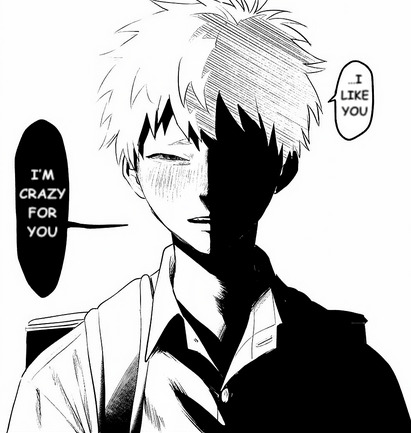
Hgsn has some incredible art and page composition, but out of the entire manga so far, to me this is the best panel of them all. Hell, this might be my favorite panel of any manga ever. (Note: Due to respecting the scanlator's wishes, I blanked out the dialogue and replaced all necessary dialogue with the official English source)
1- Build-up
Before I get to the panel itself, lets first talk about the pages before: For context, this is in chapter 2. Yoshiki has just found out about "Hikaru", and its trying to adjust to this new reality. As they walk from school to Yoshiki's house, Yoshiki asks him if he killed Hikaru. This is how the previous two pages look like:


Notice how the half shading effect is done in hatch marks. This is the first sign the all-black shading is a stylistic choice used to convey something.
Look at the balance the two pages form when you put them together: half white, half black, half black, half white. They compliment each other, both in color balance and in panel shape.
We have to turn the page to hear Hikaru's answer to Yoshiki's question. This gives the control of the narrative back to the viewer. This creates tension and build-up to it, it is a common tactic famously employed by Junji Ito in his famous "page-turner" moments where the viewer has to turn the page to see the monster. Except in this instance we are not revealing monsters, or are we?
2- The page

I'm not gonna get into too much detail on the page itself, I just want to point out the juxtaposition between the page composition of this page and the previous two. The last two were balanced and had all the panels closed while this one is much more liberal, bringing a feeling of unbalance, like something just shifted. I'd say the black and white balance is still there, with the Hikaru on white and Yoshiki on black panel side by side and all, which actually brings me to my next point:
3- Black and White
Honestly this could be an entire analysis post of itself, where do I even start?! Let's go from the very beginning. This is the very first time we learn of "Hikaru" :

Notice how the panel is colored black. In fact, throughout the story, we see black panels being spoken by "Hikaru", usually right before he does something unnatural:


And here are the only two instances we see of the Brain-snatcher's true form:


• He's literally a black blob, just like the text bubbles! And now combine that with Hikaru's white hair, and the fact his name means to be bright, and what's the brightest color but white, and there is a clear color symbolism going on:
Hikaru=White
"Hikaru"=Black
4-The Panel
And now we're back to the original panel! Taking all the other points in mind, we can analyze the panel itself

First, his expression. My G-d, his expression! His raised eyebrows and his squinted eyes, making his pupils way larger, make the expression seem almost childish and pitiful. But the half black-out face turns this pity look to an ominous one. Not being able to see the face or having your face obstructed is easy path into the uncanny valley, which I think is the case for this scene. Immediately 180 from "aww the poor guy" to "what is he hiding?"
The white panel says "I like you" while the black panel says "I'm crazy for you". HOWEVER, The white bubble is by the black side of his face and the black bubble is by the white side of his face. So which Hikaru is saying that? Is "Hikaru" crazy for Yoshiki, while Hikaru just liked him, or the other way around? Did the original Hikaru ever love Yoshiki, or is that the monster's feelings? Well we don't know! That's the premise of the whole manga! In one panel!
And that's why it's my favorite :)
#hikaru ga shinda natsu#the summer hikaru died#hgsn#tshd#yoshiki tsujinaka#hikaru indou#snal posting#the manga of all time tbh
619 notes
·
View notes
Text
That regret being falling

Suitable Manga to Review
Maybe you all detest it a lot, plus it's mosting likely to stay so cherished, but no one ever describes why it's good? For me, that is fate controlling, which was adapted into animation, offering me a reason to re-review it.
Face framework and the lips do look a little bit more human than typical it is disrupting to view and comes under the uncanny valley. The paneling is godawful, although the manga has actually described art. There isn't any flow or structure to activities, along with the literal panel space is even off, which is this type of apparent facet of a manga that you would certainly require to attempt to fuck it up. The histories are limited as well as typically not even existing, making the whole thing feel careless and also empty. Nevertheless, a lot was added by the directing in the anime to the very first tale, including a little nuance to personalities with motions as well as such, and also providing a coat of melancholy to all. It advises me of an additional program just recently that made use of guiding that is wonderful to bring a source that is uninspired to life: Re-Zero.
The characters in fate controlling absence any characteristic as well as are hollow. Teen Batman has no personality traits other than those that my nickname that is sophomoric explains. Every other character acts as a plot gadget to guarantee the audience knows that Naho is nice or to advance the narrative as well as Kakeru is the best. Having rather finished Legend expanded the actors of over 70 characters, to its 2 protagonists is unsatisfactory reviewing something with such little treatment.
The dialogue in the manga for fate controlling is required, seeming like it's trying to make clear a quote wherefore requires to take place in a phase, as opposed to being a real authentic conversation and dronish. The anime has an extra natural feeling to the dialogue, making it less complicated to watch.
manga online, instead of solid characters drive completely fate controlling, ambience or anything dumb like that. It exists to show drama, in addition to is to see the following factor of over the leading dramatization.
Is dramatization of continuing to enjoy the series, the only driving force, however it's also developed to make conflict to solve. Hide essential info from each other to make everything for them.
The last end result of fate controlling rushed and is anticlimactic. It handles to make me hate the entire bundle greater than I did, which impresses me.
The complying with paragraph is a massive looter. The series is shed. Nonetheless, because of trying to repair a regret, that regret being falling short to conserve him since he was conserved by them, the series ends up contradicting itself. Evocative Steins; Gate -face turn, rather than thematic incoherence.
I caught up right into its run regarding the current chapters on fate controlling, and also after 3 years of shitty artwork and also theatrical emptiness, it wrapped up. After defining my hatred for it, I created an awful, rambling, inadequately created testimonial. The anime started airing, and also I would certainly wish no person would certainly tell me whatever they like concerning it, as well as the anime would be excellent and that I 'd be verified wrong. While the manga was not better in connection with the anime, it failed to be acceptable as a piece of job. As well as I have yet to be explained what value are offered below, besides the small few favorable factors I've pointed out here. So, If you like checking out manga a lot, then offer this story a go.
For other related details, you could also visit
https://sorelldifilippout1.wixsite.com/allabouthealth/post/jws7o0buzci9rmaafswx1640691744
0 notes
Text
BECAUSE I’M NOT POPULAR, I’LL READ WATAMOTE: CHAPTER #117
It’s these sort of vignette-filled chapters that are starting to become my favorite lately. I think that’s because it’s not just a bunch of gags and jokes one after another like you’d find in a 4-koma manga. There’s a definite flow of time and continuity when Nico Tanigawa does these chapters. Not to mention that they still take the time to introduce character dynamics that can be built upon for later chapters/arcs.
In essence, I tend to think of these as “transition” chapters because they provide content that can be used for more self-contained stories, but can still function very well as its own chapter.
Chapter 117: Because I’m Not Popular, I’ll Greet the End of My Second Year
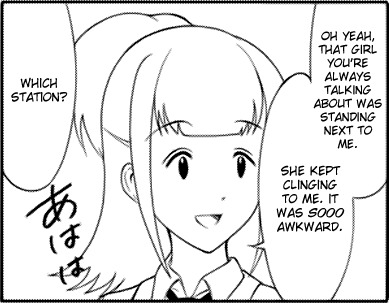
Have we given her a fanon name yet? Her panel is big enough to warrant one.
I get the feeling that if it had been some random girl pressing against her, this girl wouldn’t have thought much of it, attributing it to just a case of the train being overpacked. But because it’s Tomoko, and Ucchi mostly likely gossiped about how she’s such a creep, that it probably skewed this girl’s perception of what had happened. She was led to believe that Tomoko is some kind of touchy-feely lesbian, so that’s what she’s gonna see.

I’ll admit, I’m not familiar with how the trains work in Japan, so this confused me enough that I didn’t actually get the joke the first time. Perhaps someone can clear it up for me?
But check out Ucchi’s posture here. Sitting upright, knees together, arms out. She clearly readying herself up, and we all know why,

Yuri Tamura shows up = instantly good chapter.

It was around here that everything started to click in my head. Ucchi, in her increasingly stalker ways, was planning to get off on Inage, where she would board the opposite running train and hopefully run into Tomoko. So of course, when Yuri asks her why she’s not getting off, the prideful Ucchi isn’t about to admit that she wants to see Tomoko, so she first gives the excuse that she was sleeping. And when that doesn’t work, Ucchi lies that her legs went numb, but Yuri being the good person she is, helps her off the train.
Better luck next time Emoji Girl.

Gotta say, Yuri’s annoyance here is perfectly justified when you look at it from her perspective. She made sure Ucchi didn’t miss their stop, and even offered to carry her out of the train when Ucchi claimed her legs were numb. I’m sure at some point Yuri realized that it was all BS, and given that Ucchi appeared ungrateful for help she didn’t even need, it must have struck a nerve with her.
I’d really like to see more of these two play off against each other. It’s amusing.
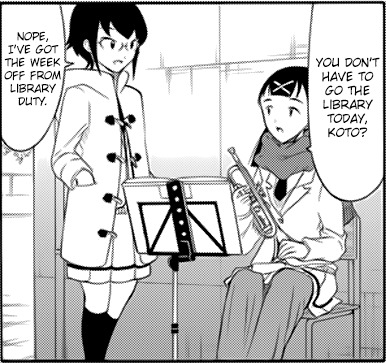
One thing I really like is that Nico Tanigawa doesn’t oversell when they’re introducing new or underused characters. Lots of manga do this by introducing them in a large panel with a text box that tells their name, age, class number, etc. But here, the mangaka is showing us who Itou is in a manner that is very natural. Here, we have a great case of show-not-tell as we learn more about Itou. She plays the trumpet, is part of the band, is a bit of a loner, and is otherwise pretty normal. I’m already awaiting for her focus chapter.
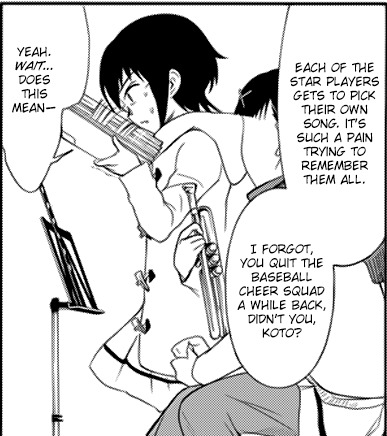
Imagines Komiyama in a cheerleading outfit.
Thankfully, my out-of-character image of Komiyama was proven wrong after a quick Google search, and I realized that they’re talking about an ōendan, which is much more in-character.
So here’s a question: why do you suppose Komiyama quit? It’s probably nothing tragic; perhaps it was just too high-energy for her. But it’s still fun to think about.
But if Tomoki ever joined the baseball team, you know she’d rejoin in a heartbeat.
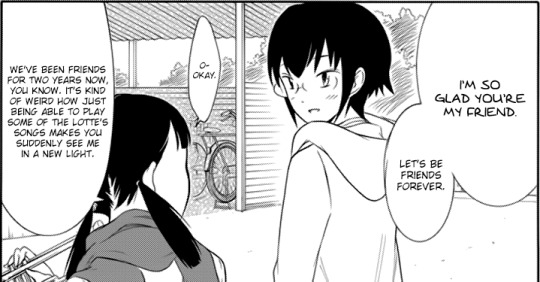
It’s always nice when Komiyama’s weirdly cute side comes out like this. Even if her impression of Itou changed from something as simple as being able to play some baseball cheer songs, I don’t think it’s a shallow relationship or anything like that. They do seem like genuinely good friends, and I do wonder a bit how they met since they’ve only known each other since high school started. In a way, It kind of parallels the whole Tomoko-Yuri friendship, with the whole creep-and-normie dynamic. I wouldn’t be pretty surprised if they became friends out of “fated” circumstances as well.
Speaking of Tomoko...
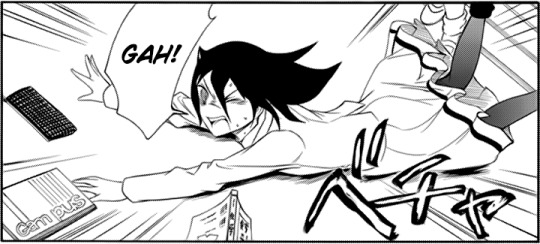
She ain’t beauty, she ain’t grace, and she falls on her fuckin’ face.
If she were a typical shoujo manga heroine, her fall would’ve been ladylike, cutesy, and with an adorable squeal to emphasize her cute clumsiness.
Cute shoujo manga heroine Tomoko is not.

Now this is one of those moments in Watamote where I was genuinely surprised. For what little we know about Minami, she seems like a cheerful, genki type who can be just a little insensitive. Too be honest, my first thought when I saw this was that Minami was laughing about something else with the no-eyes girl, and wasn’t actually laughing at Tomoko. But at the same time, I also think that her actually laughing at Tomoko is entirely plausible. It’s hard to tell, but perhaps that ambiguity is what Nico Tanigawa was going for
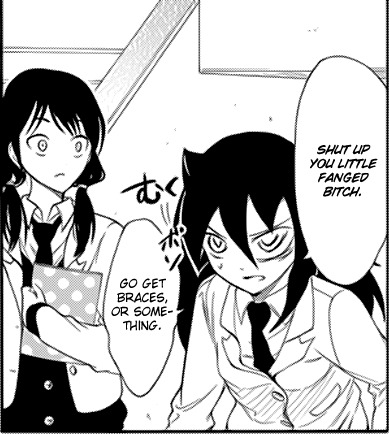
Damn, kitty-cat Tomoko grew some claws. I love how more open she’s been about expressing her ruder and cruder side.

C’mon, how could I not include this shot?
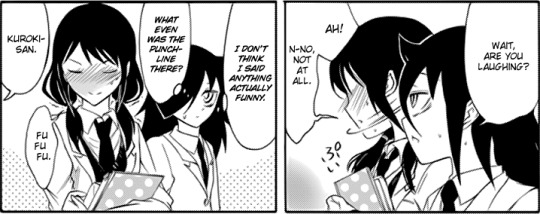
So it looks like we finally got a taste of Yuri’s sense of humor. And it’s the type of humor, that I, and I’m sure a lot of other people enjoy. The “addressing-the-elephant-in-the-room” kind of humor. The snaggletooth quality we see with Minami is usually something in manga that is only a character aesthetic. Something the readers can see, but is virtually invisible to the other characters. The fact that Tomoko so openly mocks her for something no else seems to have said is probably why Yuri finds it so funny.
It also probably helps that Yuri is not on the best of terms with Minami, so she can probably get on board with teasing her that much easier.
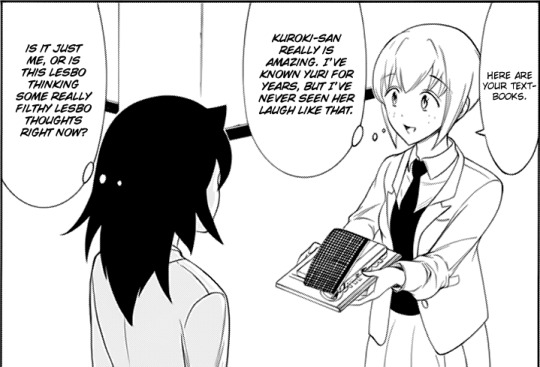
Now this is something I find really interesting. To think that Mako, who’s been Yuri’s friend for years, has never made her laugh out loud, yet Tomoko hasn’t even known her for a year, and she still got her to laugh. What does this say about Yuri’s friendship with Mako and Tomoko? For me, I think Yuri’s friendship with Mako is based on stability. They like each other enough and it’s easy to commit to without much conflict (sans Minami). With Tomoko, while they don’t fully understand each other, they seem to be helping each other break out of their shells, with Tomoko gaining confidence and Yuri being more expressive.
You know how some people were joking on how Tomoko is like a virus bringing down all the other girls to her level? I think with Yuri, Tomoko is actually bringing her up. I honestly predict that Tomoko and Yuri’s relationship will be the strongest by the end of the series.

I know I just poked fun at when manga introduce characters by giving them a panel with text over them, but I don’t think it’s necessarily a bad thing. In some instances, it can be used as a bit of comedy. For Kiyota, who is so inconsequential, having his name there to remind the audience who he is is a nice touch.
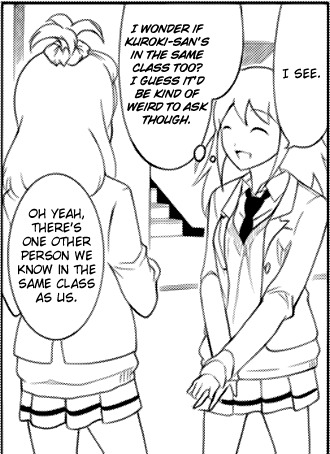
It’s times like this when I realize just how truly passive aggressive Nemoto is towards Tomoko. I can see her thought process here: if she asked about Tomoko, that would imply that she cares about her and that they’re friends, which is something Nemoto doesn’t want her real friends to consider. Nemoto doesn’t mind Tomoko, but she doesn’t want to associate with her any more than she has too. Take of that what you will.
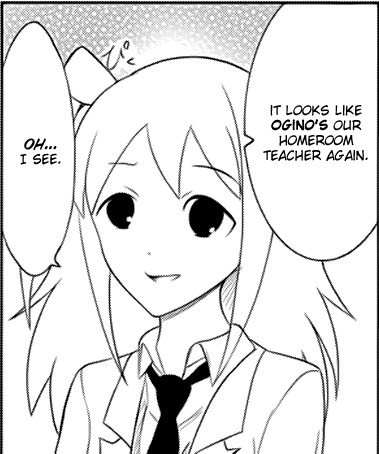
You can literally see her expression fall ten stories to the ground.

Now an impression of Ogino is something I would like to see. I don’t recall Ogino having any sort of obvious mannerism, though. Maybe it’s smiling ignorantly in a way that automatically pisses people off.

Not gonna lie, this right here hit me HARD. You see that crosshatching in the background? Nico Tanigawa usually does that for scenes that are high in tension, and this is no exception. This is the first time we’ve seen the side characters opening mock Tomoko on some level. Sure, it’s not really malicious or hurtful, but it’s still teasing Tomoko for being who she is. The scariest part is, this type of teasing falls into the uncanny valley where it isn’t outright bullying, but very close to it. I’m so glad severe bullying isn’t a part of this manga, or I might not be able to handle it.
One thing I’m sure others have noticed is that Nemoto’s impression isn’t actually Tomoko, but the side of Tomoko they’re used to seeing: the shy, nervous girl who has trouble communicating. It’s the Tomoko from first year, not the new Tomoko who is much more emotionally confident than before.
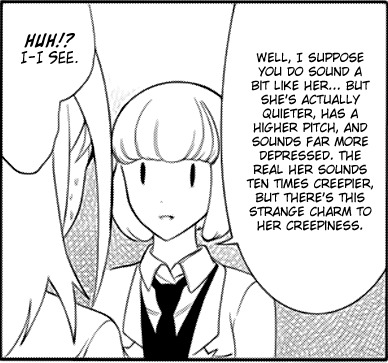
If I had been drinking something when I first read this, I would’ve most definitely done a spit-take.
With the way Ucchi is describing Tomoko, I realize this is exactly the performance that Izumi Kitta gave Tomoko in the anime (her real voice, not the voice in her head). But the level of detail is so good, that it’s actually kind of scary just how obsessed Ucchi has been. Relatively speaking, Ucchi actually hasn’t had many run-ins with Tomoko, and yet she is able to describe her so correctly and confidently.
And she actually called Tomoko charming.
It’s this line that got to me, because it’s the very first time Ucchi has admitted to liking Tomoko to any sort of degree. There’s no embarrassment, no denial, no hesitation.
If Nico Tanigawa don’t want us to ship them, then they’re sure making it hard not to.

I want to point out the way that Nemoto brought up her impression of Tomoko. She does it in a way that tries to minimize any meanness to it. By saying that her friends were laughing at it, she prevents any accusation of bullying, since it was “all in good fun”. By slouching over her desk like that, Nemoto makes the conversational atmosphere all casual, and by having Makeup-chan hear it, she has someone to potentially back her up should things turn sour.
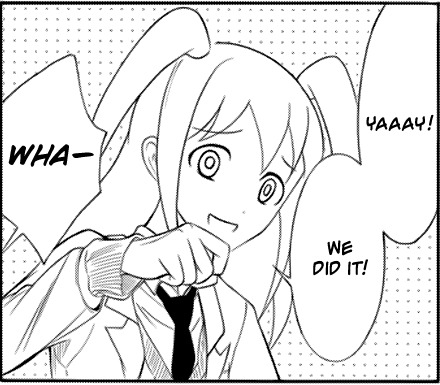
Damn, she even did the eye thing. Nemo is merciless.
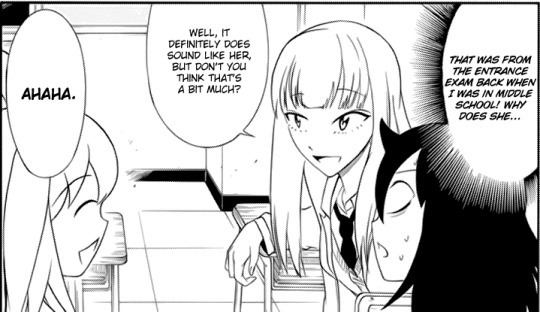
Tomoko.exe stopped working.
I’m sure a thousand thoughts are flooding Tomoko’s mind right now. And from the looks of things, I’m sure Tomoko came to the conclusion that yes, that was Nemoto who she fist-bumped that day. I’m glad that Makeup-chan managed to ease the tension before things got too ugly. And of course Nemoto would laugh it off, like it’s no big deal.
People like to say that Nemoto is shaping up to be the villain in this manga. While I wouldn’t go that far, I do think she has the potential to go there should the manga ever decide to go that route.
Whew! This was a long one! There was so much to unpack this time as opposed to the four pages from the last chapter. That’s no criticism, however, as I would gladly review fifty pages a chapter if they’re all as good as this one. The character dynamics, both new and old, were spot-on and offers many layers to dissect. At this point, there is no character who I don’t like, and that’s the highest compliment I can give. Because even the most disliked characters are as such because you like them that way. The manga has perfected naturalistic awkwardness to a T. I feel like every chapter, Nico Tanigawa sets itself up to a higher standard, that I wonder just how they’ll top the previous chapter.
So, next time Yoshida?
#watamote#watamote review#no matter how i look at it it's you guys' fault i'm not popular!#chapter 117#tomoko kuroki#ucchi#yuri tamura#kotomi komiyama#itou#minami#mako#hina nemoto#okada#kiyota#katou#review
32 notes
·
View notes
Text
g&p readings 2:
Keeping in theme with the themed readings, this week’s theme brought semiotics to the table. I am almost 100% sure we covered this in Studio last year and so my understanding of the topic should be covered in a previous blog.
As a foreword though, I’ll begin my reflection by redefining the concept at hand: semiotics, at its core, refers to the study of signs and symbols and the significance that stems from these. This communication can retain the form of language, an object or even a dynamic relationship between entities. As such, semiotics can undertake both physical and abstract presence.
Blood in the Gutters
by McCloud
I feel as if this reading is important to begin critiques with as it overflows ideas into the following text. Blood In the Gutters is a unique medium detailing a sub-genre of semiotics in that it is presented in comic form. Not only is it fun to read, but proposes interesting ideas as well.
The premise of this particular chapter ideates the term ‘closure’, or rather, the act of observing the parts, but perceiving the whole. As a wider metaphor, McCloud uses the space between comic panels as a prevalent form of closure. In a transition scene between an axe above someone’s head, to a bloodcurdling scream in the night, who really becomes the killer in the situation? While we are presented with heavy evidence that person X is about to be murdered, we are never explicitly told that they have died. Yet, in the centimetre space between pictures, we have written them off almost immediately. We, the viewers, are responsible for person X’s death as much as person Y simply through the power of assumption, also known as closure.
A ‘gutter’ in comic lingo is the space between panels that create a sense of mystery, a limbo of ideas if you will. Preceding panels create notions in our head that we expect to see in the next, which we then pour into the gutter; think, the automatic animation generation between keyframes in Adobe Flash. McCloud proposes that the reconstruction of the gutter is merely a byproduct of the human sense to commit closure, since we naturally fill gaps in unfinished concepts.
Closure is an extremely vital component of semiotics. When we see a red sign, do we not start to analyse everything that it stands for? Picture a three panel comic: the first is of someone driving a car, the second a stop symbol, the third a grave. Here, the application of semiotics aids the concept of closure. A panel two indicates the need to stop as the road ahead may be dangerous, while panel three implies the death of the protagonist. Here, closure allows the gutter to be flooded with assumptions about the person’s inability to react appropriately to the sign, leading to their death.
In comic media, closure exists in six variations (named transition scales).
Moment to moment - sequential movement
Action to action - actions lead to a reaction
Subject to subject - similar subjects within the same scene
Scene to scene - similar subjects across space and time
aspect to aspect - similar places/ideas/moods
non-sequitur - no relationship of subjects
Interestingly enough, Western storytelling tends to use scales two-four, while Eastern stories cover a wide range of the transition scales. McCloud attributes this quirk to the Eastern’s fondness over silence amongst panels, where the West requires action. Silence however allows for the phenomenon of fragmentation to occur, in which the viewer is given pieces of the puzzle without actual context. In this way, closure, along with natural imagination, is more easily performed as they have more room to ‘fill in the gaps’ and create an internal narrative.
Other supporting evidence McCloud brings to the previous point is the realism versus stylistic art styles of the West and East respectively. Western comics love to edge close to human like appearance due to their typical hero-idol role in society. Meanwhile, the East with, let’s say manga, use exaggerations of the human form which are idealised versions of their society. Because the reader is able to detach themselves from reality due to the art style being less realistic, Eastern manga leaves more to the imagination and thus forms more closure. The concept is similar to the uncanny valley.
Overall, I found this reading to bring up extremely important points, particularly in relation to semiotics. The wider metaphor of the comics and their gutters leave closure a much easier concept to understand. The same thought processes can be applied to the rest of the readings.
Proteus (Podcast)
by Cane and Rinse
With a name like that, I was half-expecting a slither.io clone, or a Mass Effect remake. To my pleasant surprise, neither case was true. An exploration sonic game developed by Ed Key and David Kanaga, Proteus is procedurally-generated, “non-tradtional and nonviolent,” where interactions with flora and fauna are placed to the utmost importance.
The player awakens in the sea with an island before them. This plot of land can be explored throughout day and night, as well as through the seasons. As winter passes, the game ends. Truly, as the commentary podcast describes it, Proteus is minimal to its core. Even as the player is thrown into a foreign landscape, no controls - including how to open the menu - are provided. It is a game entirely about exploring both in the virtual sense, as well as the real world.
Here, fragmentation (as explained in the previous reading) becomes a core mechanic towards the actual enjoyment of the game. This metaphorical ‘silence’ forces the player to create a narrative in their head. “What happened at point A to get me to point B?” Only you can make assumptions and create closure.
Ironically enough, this silence is only magnified by the exquisite soundtrack of this game. Imagine a Minecraft world, stripped of everything but a synth remix of the Ocarina of Time playing. Seriously, it was that relaxing, and I only watched a playthrough of it. Comparisons aside, the use of sonics in this game is another key example of semiotic use. Sounds vary depending on actions taken (e.g. chasing animals), phenomena appearing (e.g. stars lining up), or seasons changing. Each note trains the user to associate the coming and passing of an event; each note becomes symbolic, acting like a ‘sign vehicle’ (see: semiotics papers).
The pixelated nature of the game also ties into McCloud’s analysis of visuals. Proteus, in theory, is so ugly and basic that it actually presents like a beautiful landscape. Everything about this game is outdated and boring, but playing it generates an entirely different experience. Again, because it does not slip into the uncanny valley of realism, nor into the abstract of weird visuals, /Proteus/ becomes a medium able to receive closure, and thus, be a port of interest.
The associated podcast felt more like commentary on the mechanical aspects of the game than anything else, although did serve useful providing insightful thoughts and game hacks.
Problem Attic
By Ella Guro
Again with the name expectations, though this time, the assumption is completely atticurate. Get it.
Excusing the bad puns, I would like to begin by mentioning that I am a sucker for psychological games, ones that make you think because they don’t fit the mould of traditional styles. This understandably left me torn.
On one hand I hate the art style. It falls exactly into McCloud’s trap of ‘too abstract’ because the sprites are not craftily made interpretive pieces, but instead form a cacophony of pixels inelegantly rendered. Proteus made use of a low-fi ambience, but Problem Attic is more jarring, a sight for sore eyes so to speak. However, in this regard, I also appreciate what the game has to bring to the table.
From a semiotic standpoint, it bodes a wealth of mineable information; /Problem Attic/ is riddled with signs and symbols. The only problem is that we have no idea what they mean. In semiotics, a successful sign delivers itself to its interpreter, or at least indicates ideas when picked apart.
Closure becomes particularly key in the latter because it allows spectators to view the whole from the sum of its parts. Proteus is successful in its silence because we are able to understand the direction of the game from the get-go. We wake in the water, an island before us. The logical mind - forming closure, by the way - exhibits the desire to walk towards that land. Thus, a ‘journey’ status quo is established. Meanwhile, Problem Attic throws the player into a hideous green environment dotted with questionable tilesheets. What is the context behind the protagonist’s arrival? What direction must he go? Are there any indications of goals? Yes, Problem Attic establishes a narrative through the otherworldly teleportation levels, it almost becomes a chore for one to find closure the wider existence of this game.
Stated earlier, semiotics aids closure in its ability to create assumptions from one event to another, Problem Attic does this, but struggles in forming the final panel of where limbo ends. Perhaps had Problem Attic had slightly more finesse behind it, would it be more enjoyable for players.
Don’t get me wrong, I enjoyed this game and appreciate the symbolism behind the ominous facade, I simply think that it is too difficult to boil it down to a ‘good game’ in a theoretical sense
-m
0 notes
Text
The backgrounds are scarce and also commonly not also current
Decent Manga to Review
Possibly you all dislike it so much, plus it's going to continue to be so cherished, but no person ever discusses why it's great? For me, that is hoshino me o tsubutte manga, which was adapted right into animation, giving me an excuse to re-review it.
Facial framework and also the lips do look a bit much more human than normal it is disrupting to view and falls under the uncanny valley. The paneling is shocking, although the manga has detailed art. There isn't any type of flow or framework to activities, in addition to the actual panel area is also off, which is this type of noticeable element of a manga that you 'd need to attempt to fuck it up. The backgrounds are scarce and also commonly not also current, making the whole point feel careless and empty. Nevertheless, a great deal was added by the directing in the anime to the initial story, including a little nuance to characters via motions as well as such, and providing a coat of melancholy to all. It advises me of another show lately that utilized directing that is excellent to bring a source that is uninspired to life: Re-Zero.
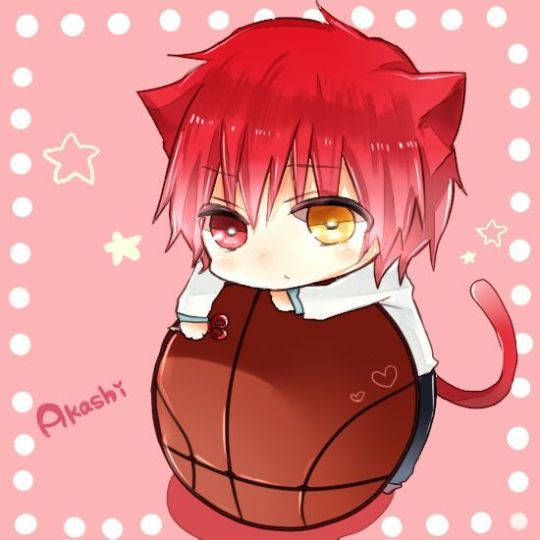
The personalities in hoshino me o tsubutte manga absence any kind of characteristic as well as are hollow. Teen Batman has no personality traits aside from those that my nickname that is sophomoric defines. Every other personality works as a plot gadget to guarantee the target market recognizes that Naho behaves or to enhance the story and also Kakeru is the most effective. Having somewhat completed Legend fleshed out the cast of over 70 personalities, to its two lead characters is frustrating reviewing something with such little care.
The dialogue in the manga for hoshino me o tsubutte manga is required, feeling like it's trying to make clear a quote for what needs to take place in a chapter, as opposed to being a real conversation and also dronish. The anime has a much more natural feel to the dialogue, making it less complicated to view.
i am behemoth of the s rank monster but i am mistaken as a cat and i live as a pet of elf girl manga, instead of strong personalities drive totally hoshino me o tsubutte manga, environment or anything foolish like that. It exists to show drama, in addition to is to see the next point of over the top dramatization.
Is drama of remaining to enjoy the collection, the only driving pressure, however it's additionally produced to make dispute to fix. Conceal important information from each other to make whatever for them.
The final end result of hoshino me o tsubutte manga rushed and is anticlimactic. It manages to make me hate the entire bundle greater than I did, which impresses me.
The adhering to paragraph is a huge looter. The series is shed. However, due to trying to deal with a regret, that are sorry for being stopping working to conserve him since he was conserved by them, the series winds up contradicting itself. Similar to Steins; Gate -face turn, as opposed to thematic incongruity.
I captured up into its run concerning the latest phases on hoshino me o tsubutte manga, and also after 3 years of shitty art work and theatrical emptiness, it ended. After describing my disgust for it, I created a dreadful, rambling, inadequately composed review. The anime began airing, and also I 'd really hope no person would inform me whatever they such as about it, in addition to the anime would certainly be superb and that I 'd be verified wrong. While the manga was not much better in connection with the anime, it stopped working to be appropriate as a piece of work. And also I have yet to be discussed what merit are readily available here, besides the minuscule few positive factors I've stated here. So, If you like reading manga so much, then give this story a go.
Find out more related details at
https://thepaintingblogs.puzl.com/_news/He-takes-place-to-conserve-a-few-of-his-fellow-trainees/258087
0 notes